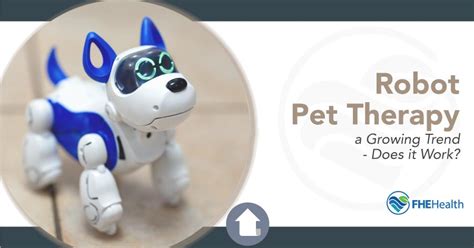Introduction
The world of healthcare is rapidly evolving, and the field of occupational therapy is experiencing a surge of technological advancements. One of the most promising breakthroughs is the emergence of AI robot pets. These innovative devices are revolutionizing the way therapists assess, rehabilitate, and enhance the lives of patients. This article examines the potential of AI robot pets in occupational therapy, exploring their advantages, applications, and future prospects.

Benefits of AI Robot Pets
Enhanced Engagement and Motivation AI robot pets can create a sense of companionship and purpose that can enhance engagement and motivation in therapy sessions. The interactive nature of these devices allows patients to establish a bond and develop a sense of responsibility for caring for their robotic companion. This can lead to increased participation and adherence to therapy protocols.
Improved Cognitive Function AI robot pets have been shown to stimulate cognitive function in patients with various conditions. The interaction with these devices can improve attention, memory, and problem-solving skills. Additionally, the ability to program and control the robot pet can promote logical thinking and creativity.
Increased Physical Activity For patients with physical limitations, AI robot pets can provide a safe and engaging way to increase physical activity. They can encourage movement, balance, and coordination through guided exercises and interactive games.
Applications in Occupational Therapy
Rehabilitation Post-Stroke AI robot pets have proven effective in supporting the rehabilitation of stroke patients. The interaction with these devices can help restore motor function, improve cognitive abilities, and enhance emotional well-being.
Sensory Integration Sensory integration disorders are commonly encountered in occupational therapy. AI robot pets can provide a safe and controlled environment to stimulate the senses, promoting sensory processing and integration.
Pediatric Therapy AI robot pets offer numerous benefits for children in occupational therapy. They can assist in developing motor skills, enhancing social interaction, and addressing emotional challenges.
Comparative Analysis: AI Robot Pets vs. Traditional Therapy
Advantages of AI Robot Pets
- Enhanced engagement and motivation
- Improved cognitive function
- Increased physical activity
- Potential for remote therapy
- Cost-effectiveness in certain cases
Disadvantages of AI Robot Pets
- Initial investment cost
- Limited interaction compared to human therapists
- Ethical concerns regarding the use of AI in healthcare
Future Trends and Improvements
Personalized Therapy AI robot pets are expected to become increasingly personalized, tailored to the specific needs and preferences of individual patients. This will enhance their effectiveness and improve patient outcomes.
Integration with AI-Powered Assessments The integration of AI robot pets with AI-powered assessment tools will provide therapists with valuable data on patient progress and performance. This will enable more accurate and timely decision-making.
Remote Therapy Advances in technology will enable AI robot pets to be used for remote therapy sessions. This will expand access to occupational therapy services for patients in rural or underserved areas.
Tables
Table 1: Benefits of AI Robot Pets in Occupational Therapy
| Benefit | Description |
|---|---|
| Enhanced Engagement | Increased motivation and participation in therapy |
| Improved Cognitive Function | Stimulates attention, memory, and problem-solving |
| Increased Physical Activity | Encourages movement, balance, and coordination |
| Sensory Integration | Provides a controlled environment to stimulate the senses |
Table 2: Applications of AI Robot Pets in Occupational Therapy
| Application | Benefits |
|---|---|
| Rehabilitation Post-Stroke | Restores motor function, improves cognition, enhances well-being |
| Sensory Integration | Promotes sensory processing and integration |
| Pediatric Therapy | Develops motor skills, enhances social interaction, addresses emotional challenges |
Table 3: Advantages of AI Robot Pets vs. Traditional Therapy
| Advantage | AI Robot Pets | Traditional Therapy |
|---|---|---|
| Enhanced Engagement | Yes | Can vary |
| Improved Cognitive Function | Yes | Yes |
| Increased Physical Activity | Yes | Yes |
| Potential for Remote Therapy | Yes | No |
| Cost-Effectiveness | Can be cost-effective in certain cases | Generally more expensive |
Table 4: Future Trends and Improvements in AI Robot Pets for Occupational Therapy
| Trend | Description |
|---|---|
| Personalized Therapy | Tailored to individual patient needs |
| Integration with AI-Powered Assessments | Provides data on patient progress |
| Remote Therapy | Expands access to occupational therapy services |
Strategies for Implementation
Effective Strategies for Implementing AI Robot Pets in Occupational Therapy
- Conduct thorough research on available options
- Establish clear goals and objectives for their use
- Train therapists on the use and benefits of AI robot pets
- Integrate them gradually into therapy sessions
- Monitor patient progress and make adjustments as needed
- Address ethical concerns and ensure patient consent
Tips and Tricks
- Choose AI robot pets that align with the specific needs of your practice.
- Involve patients in the selection and programming process to enhance engagement.
- Use AI robot pets in conjunction with other therapeutic modalities to maximize benefits.
- Seek feedback from patients and therapists to optimize their use.
- Stay up-to-date on the latest advancements in AI robot pets for occupational therapy.
Market Insights
Market Insights for AI Robot Pets in Occupational Therapy
- According to a study by Grand View Research, the global market for AI robot pets is projected to reach $2 billion by 2025, with a significant portion attributed to occupational therapy applications.
- The increasing prevalence of neurological disorders, such as stroke and dementia, is driving the demand for AI robot pets in healthcare.
- Technological advancements and the integration of AI are expected to expand the capabilities of AI robot pets and enhance their effectiveness in occupational therapy.
Conclusion
AI robot pets hold immense promise for revolutionizing occupational therapy. Their ability to enhance engagement, improve cognitive function, increase physical activity, and provide potential for remote therapy makes them a valuable tool for therapists and patients alike. By understanding their benefits, applications, and future trends, occupational therapists can harness the power of AI robot pets to provide innovative and transformative care in 2025 and beyond.





















